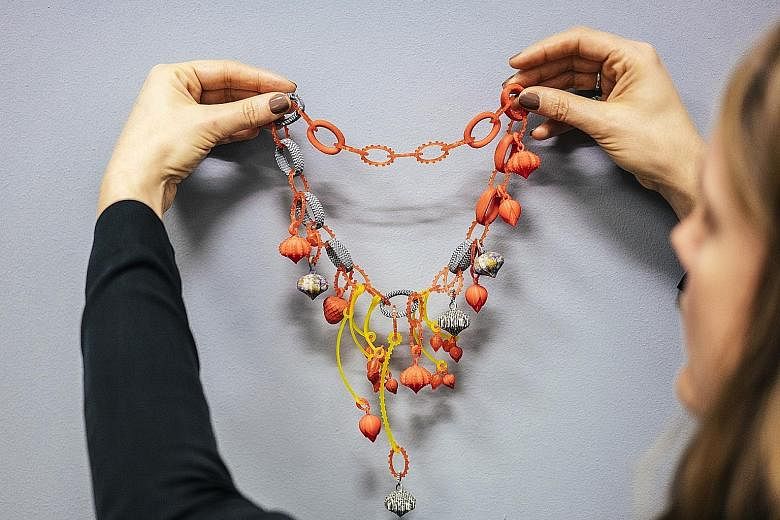NEW YORK • Over the last decade, 3D printers have become an established part of the jeweller's tool kit, a fast and efficient way of testing designs and offering customisation to consumers. A number of designers are now pushing the boundaries of the technology and finding that it opens new doors to realising their creativity.
When London-based designers and goldsmiths Alice Cicolini and Melanie Georgacopoulos decided to embark on a collaborative project that focused on design experimentation rather than commerce, they chose 3D printing specifically because neither was familiar with it.
"3D printing is becoming embedded in the industry as a useful tool and we wanted to explore whether it can print an object that you can just pick up and wear," Cicolini said, adding, "It was important for both of us that we would make something that we couldn't create any other way."
Her necklace, an intricate jumble of her signature lotus and dome motifs printed in plastic and resins using a variety of 3D printing techniques, would be forbiddingly heavy to wear if it were made of gold and precious stones.
After months of research and trial and error, she discovered that the technology also allowed her to experiment with pattern and colour in ways not possible with her customary enamelling techniques.
Producing both monochrome and coloured versions of the design, she was particularly drawn to the ceramic process, in which a four-colour pattern can be precisely applied to a piece as it prints in a bed of granular ceramic.
"The patterns I created wouldn't be possible with enamelling," she said.
Despite the project's unexpected complications and costs (Georgacopoulos said the printing alone of one necklace cost about £1,000, or S$1,787), the jewellers are refining techniques and designs to expand the project to a collection of limited-edition pieces at more affordable prices.
"This is just the first chapter," Georgacopoulos said.
Marie Boltenstern is among the first designers to create directly printed 3D precious metal jewellery.
The designer, who is based in Berlin and describes herself as a jewellery architect, applied her experience in architecture, engineering and computational design to create Resonance, a gold and platinum collection featuring a complex network of individually designed links inspired by fish and reptilian scales, to ensure fluidity and fit.
"On the one hand, scales are very rigid and protective," she said, "and on the other, they adapt completely to the surface of the body."
The central piece in the collection, an 18-karat gold wide bracelet that sells for approximately €28,000 (S$42,079), is printed over a period of 20 hours on a machine developed by Cooksongold, a jewellery equipment supplier in Birmingham, England.
The printer builds the pieces by melting together gold, silver or platinum powder, layer by layer, with a precise laser.
Boltenstern pointed out, however, that cutting-edge and traditional techniques must be combined to ensure a high-level finish.
Experienced artisans at her father's jewellery company, Boltenstern, in Vienna, polish each piece by hand, once the prints are fully assembled, setting it with gemstones if requested by the customer.
"One cannot function without the other," she said.
NYTIMES

